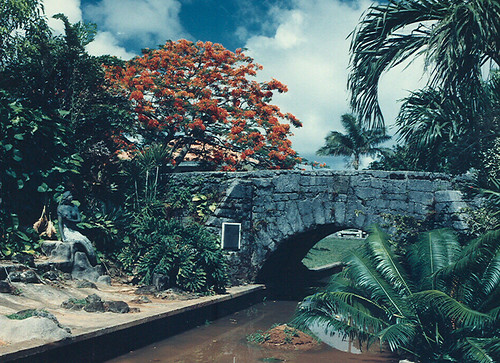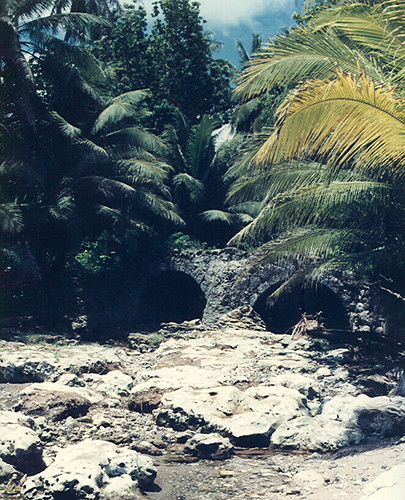de Silleria
Hand-cut stones
During Spanish colonial rule on Guam, the Spanish authorities constructed the best churches and the best bridges of large rectangular hand-cut stones, or de silleria. In these de silleria structures they did not cover the dressed limestone or coral blocks with plaster. Rather, skilled workers set the carved stones in place on a coral rock foundation and bonded the stones together with thinly mortared joints. They buttressed these large cut-stone walls to give them greater structural integrity.
In de silleria buildings a wood framework supported a barrel or curved terra-cotta tile (or teha in CHamoru/Chamorro) roof. Raised ifil, Intsia bijuga (ifet in CHamoru) floors were most common but occasionally, builders used stone or tile flooring. The de silleria buildings had wooden doors and wooden shutters or metal bars on the windows.
The earliest de silleria building in Guam was the 1709 Dulce Nombre de Maria Church in Hagåtña. The church had a sacristy and three altars. This church was beautifully and lavishly decorated according to Spanish custom. Inside this massive church there were silver and gilded lamps, and wooden statues of saints. The church in Hagåtña incorporated a modification of the “basilica” or “cruciform” plan. The 1709 church had three naves and if viewed from above, it was in the shape of a cross.
Canteros, de silleria crafters
The craftspersons, who practiced de silleria construction, were referred to as canteros. In early Spanish times ma’estron albanil (or mason, ma’estron atbanet in CHamoru) designed de silleria projects and taught Spanish stone cutting and construction skills to people in Guam. A ma’estron diobra supervised the work. Construction supervisors included the cost of the tools and the constant repairing of the tools in the estimates of building costs.
The canteros quarried stone from the reef or inland sites with a kudu (pry bar). For de silleria construction it seems likely that they collected some loose inland stones as well, because the inland stone made stronger buildings. It is specifically recorded that in the neighboring island of Tinian (now a part of the Commonwealth of the Northern Mariana Islands) the people constructed a church, in part, of stone from the numerous latte sites. This seems likely in Guam as well, and may account for the lack of latte found in the once populous ancient villages such as Hagåtña and Hågat. Latte are two-part stone supports for important ancient CHamoru buildings and demonstrate considerable stone-cutting skills in Guam prior to the arrival of the Spanish.
Skilled workers cut the quarried stone by pounding a senset (chisel) with a mattiyu (hammer). A master mason used a square, level, and plumb. The mason used a kichula or a cuchapia (trowel) to place mortar between stones. When the chisels were worn to only a few inches long the canteros used them as wedges to break rock. In other Spanish colonies, stone workers used saws to cut coral stone blocks, but there is no evidence of this in Guam.
The cantero used a regla (straight edge) to make sure the stones were flat and to draw lines on the rock faces. In these final stages the craftsperson used an achuela (adze) to smooth the exposed surfaces of the stone. The cantero smoothed the rock with a piedra de afilar (grindstone) when the cut stone decorated the interior of a church.
Concrete was not used during Spanish times in Guam. Masons made mortar of local sand, lime and water. In de silleria construction the cantero used the mortar to bind stones together. The CHamorus fired weathered coral rocks to make the slaked lime for the mortar. This firing technique was not new to CHamorus because they used it to make afok (calcium hydroxide) to sprinkle on pugua’ (betel-nut, Areca catechu). Chewing pugua’ probably dates back to the first settlers on Guam.
Remaining structures
De silleria structures were rare in Guam. Spanish authorities built the 1709 Dulce Nombre de Maria Church in Hagåtña, and the best stone bridges out of dressed stone blocks. Some stone bridges survive today.
In the southern village of Hågat along the west coast of Guam the Taleyfac and Taelayag Spanish bridges, both constructed in the 19th century, are still standing. The Talelyfac bridge consists of two stone arches over the Taleyfac River, and initially measured thirty-six feet in length by fifteen feet in width. Wood timbers were used in the original construction for flooring, but were later replaced by a rock and dirt floor. Throughout the decades, the structure has suffered from deterioration caused by erosion or manmade destruction.
The Taelayag Bridge stands over Taelayag Creek south of Hågat village. The bridge has a single eight foot ten inch arch spanning the stream. The road surface of the bridge is twenty-seven feet long by nine feet five inches wide and is more than six feet above the water level.
The Spanish Bridge at Sella Bay, located in an isolated area on the southwest coast of Guam between Hågat and Humåtak, is 96 feet long on the inland side, but only 36 feet long on the seaward side. The bridge’s roadway is 11 feet six inches wide. The structure’s arches are just over 12 feet wide.
The bridge, probably built during the 18th century, was part of the Spanish coastal highway. It was part of the road which connected Humåtak, the port-of-call for the galleons, with the capital of Hagåtña.
The San Antonio Bridge or Tollai Acho (stone bridge) is the only remaining Spanish-era bridge in the island’s capital of Hagåtña. The structure was constructed during the administration of Governor Manuel Muro (1794 – 1802) in 1800, and was dedicated to San Antonio de Padua who is depicted on a keystone, which remains today on the bridge. The river that once flowed under the bridge was diverted after World War II during reconstruction of the island’s capital. In 1966 restoration efforts were made on the structure, although not to its original condition. The site is now a park, located along Marine Corps Drive.
By Lawrence J. Cunningham, EdD
For further reading
Haynes, Douglas E., and William L. Wuerch. Historical Survey of the Spanish Mission Sites on Guam 1669-1800. 2nd ed. MARC Educational Series 9. Mangilao: Micronesian Area Research Center, University of Guam, 1993.
Ibañez del Carmen, Aniceto, OAR, and Francisco Resano del Corazón de Jesús, OAR. Chronicle of the Mariana Islands: Recorded in the Agaña Parish Church 1846-1899. Translated, annotated, and edited by Marjorie G. Driver and Omaira Brunal-Perry. Mangilao: Micronesian Area Research Center, University of Guam, 1998.
Lévesque, Rodrigue. History of Micronesia: A Collection of Source Documents. Vol. 11, French ships in the Pacific, 1708-1717. Québec: Lévesque Publications, 1997.
Pelikan, Jaroslav Jan. The Christian Tradition: A History of the Development of Doctrine. Vol. 1, The Emergence of the Catholic Tradition. Chicago: University of Chicago Press, 1971.
Ruth, H. Mark, Jack B. Jones, and Morris M. Grobins, eds. Guidebook to the Architecture of Guam. Taipei: Guam and the TTPI Chapter of the American Institute of Architects, 1976.




